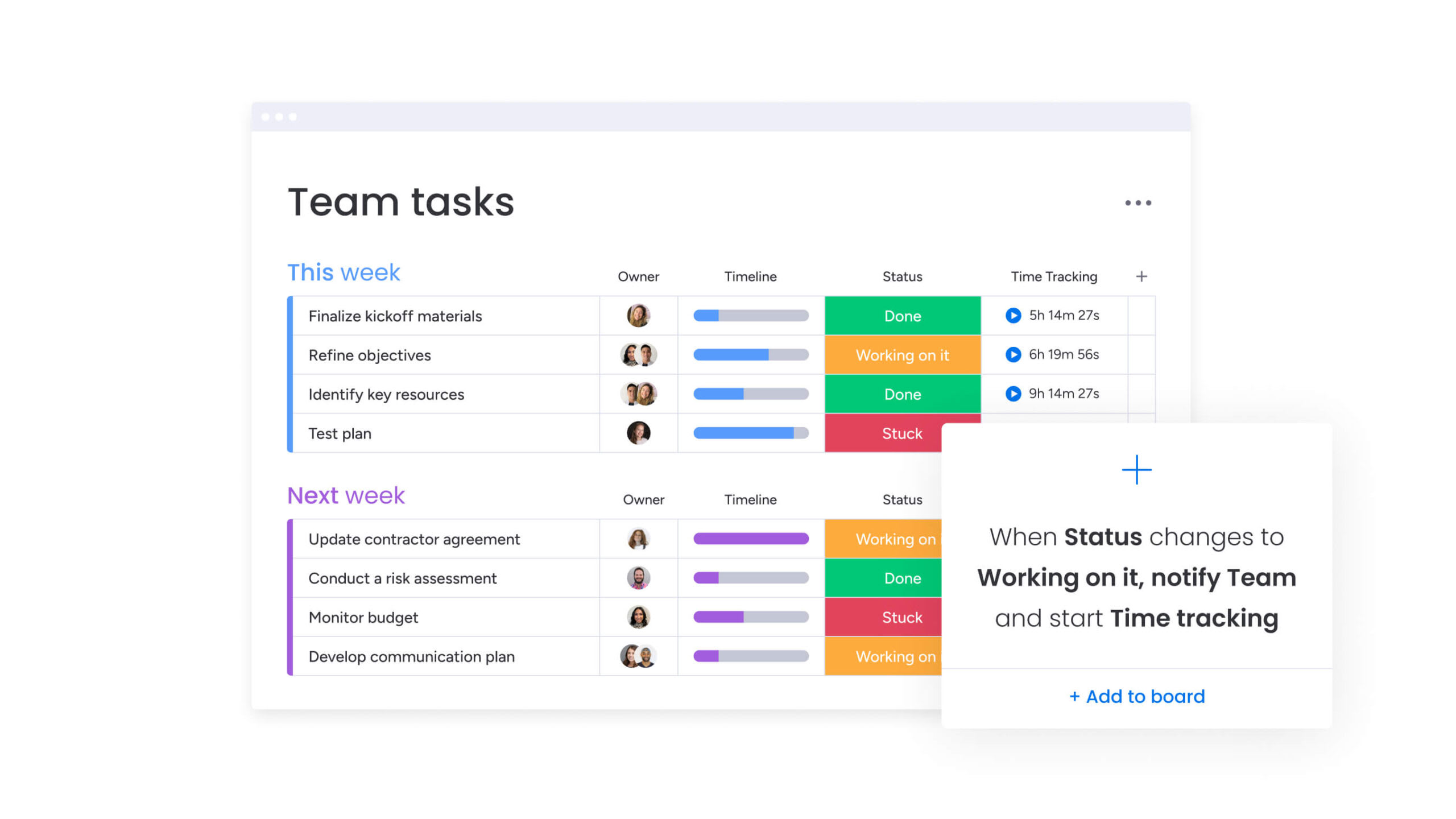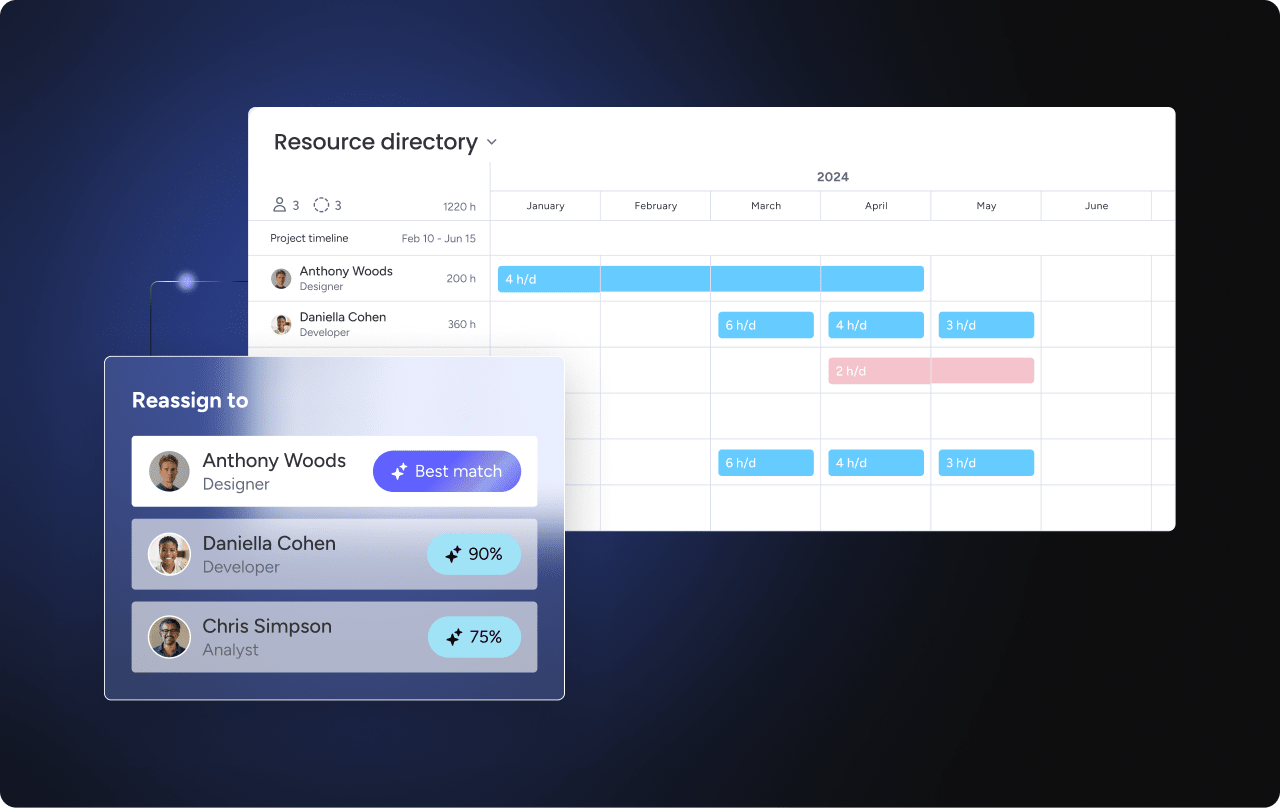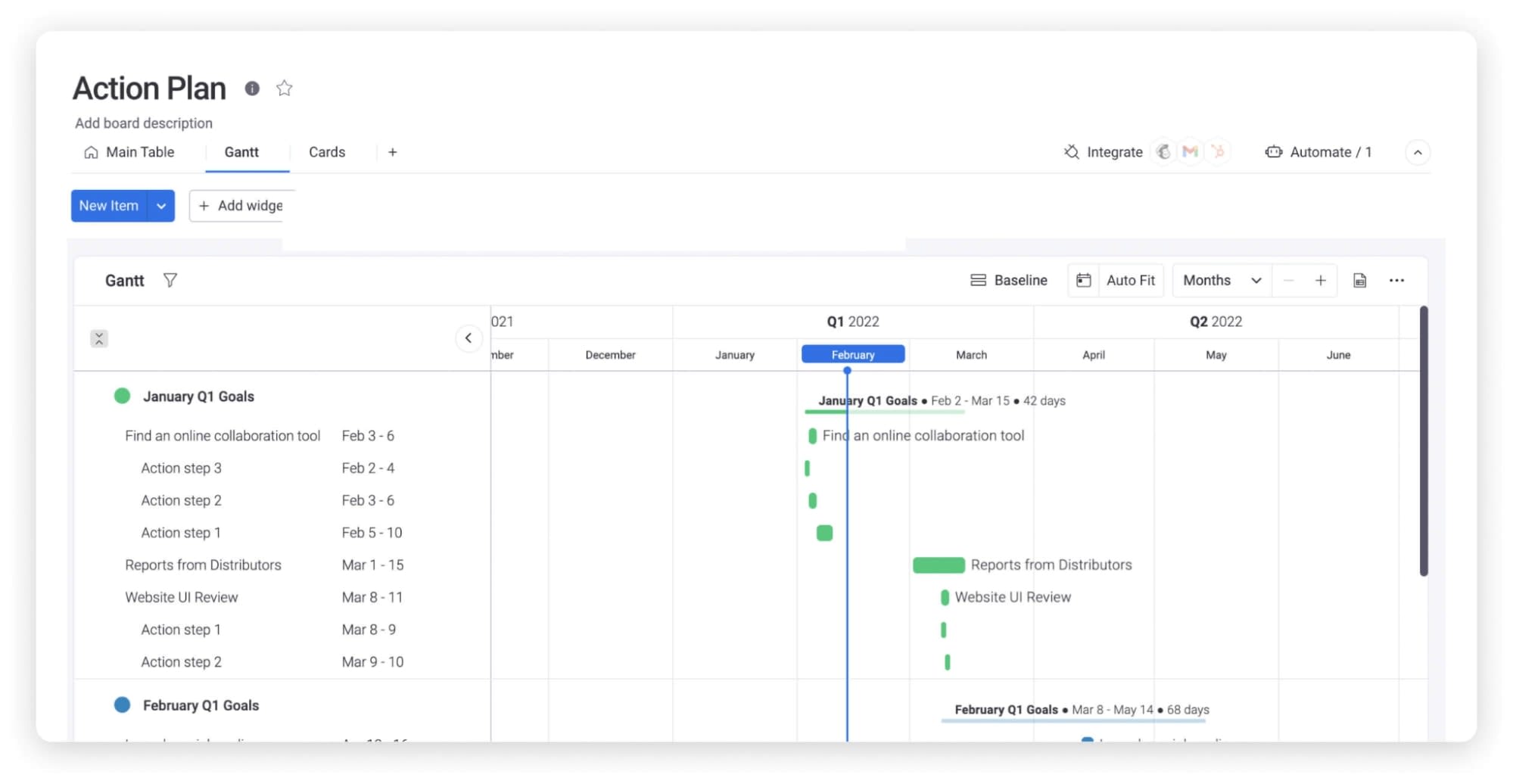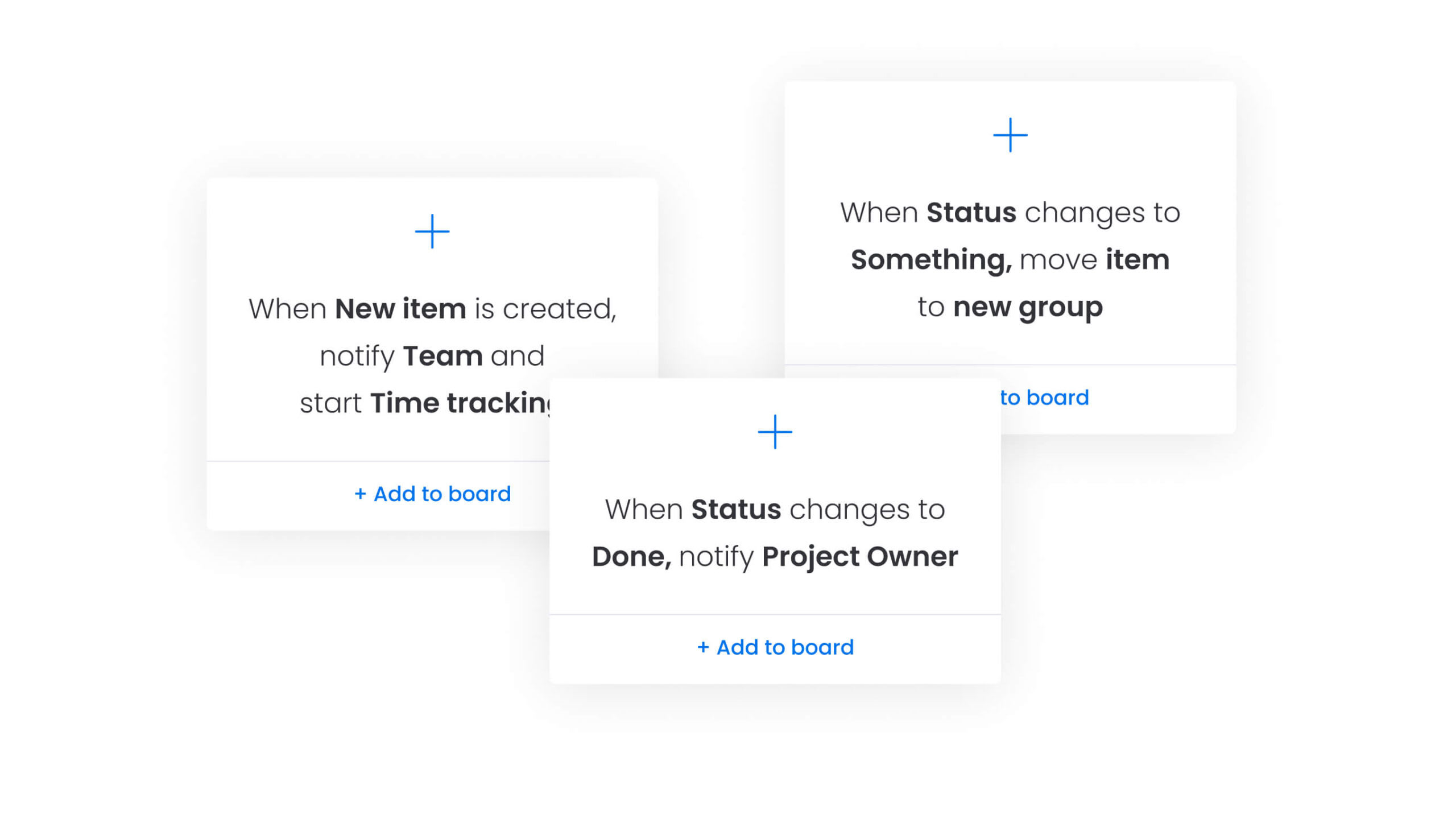Every team dreams big, but without a clear plan, even the boldest goals can get lost in the shuffle of shifting priorities and scattered efforts. The difference between wishful thinking and real progress? A powerful action plan that translates vision into results.
This guide walks you through the key steps for building an action plan that actually works, from defining precise goals and breaking them into actionable tasks, to assigning ownership and tracking progress in one place. We’ll also show how software — like monday work management — brings these steps to life with visual workflows, automation, and real-time collaboration that turn plans into reality.
Try monday work managementKey takeaways
- An action plan transforms vague goals into concrete, trackable steps by breaking down objectives into specific tasks with clear deadlines, ownership, and success metrics.
- Strong action plans need 5 essential elements: specific measurable objectives, detailed task breakdowns with dependencies, realistic timelines with buffer time, clear role assignments, and defined progress tracking methods.
- Success depends on regular reviews and refinements that keep your plan relevant as conditions change, allowing you to pivot intelligently while maintaining focus on your core objectives.
- Visual management and automated tracking prevent small problems from becoming project killers by making progress immediately visible and alerting teams when tasks fall behind schedule.
- Action planning gets a boost in monday work management, where real-time collaboration, visual workflows, and automated progress tracking help keep teams aligned and accountable from start to finish.

What is an action plan?
An action plan is a detailed roadmap that breaks down a goal into specific steps, deadlines, and responsibilities. Think of it as your project’s GPS. Just as GPS shows you each turn to reach your destination, an action plan shows you each task needed to reach your goal. Without it, you might know where you want to go but have no idea how to get there.
The key difference between an action plan and a simple to-do list lies in structure and strategy. An action plan connects tasks to larger objectives, assigns clear ownership, and includes timelines and resources. While a to-do list tells you what to do, a plan of action tells you why, when, how, and who should do it.
Why you need an action plan
Ever watched a project fall apart because everyone had different ideas about what needed to happen? That’s what action plans prevent. They create a single source of truth that keeps teams aligned and moving forward together.
Action plans turn abstract strategic goals into measurable progress. When you document each step, assign owners, and set deadlines, you create accountability that drives results. Teams know exactly what’s expected and when it’s due.
The real power of an action plan comes from visibility. With software like monday work management, your action plan becomes a living document where everyone can see progress in real time, eliminating the need to hunt down status updates. No more wondering if tasks are on track or hunting down status updates.
Key elements of a strong action plan
Every effective action plan shares a common DNA — the essential elements that turn broad ambitions into focused, achievable outcomes. Here’s what to build into your action plan so it works in the real world, not just on paper.
- Measurable objectives: Your objective forms the foundation of your action plan, and it needs to be specific and measurable. Instead of “Improve customer service,” be concrete with “Reduce average response time from 48 to 24 hours by Q2.”
- Task breakdown: Each major goal splits into smaller, manageable pieces. These tasks need enough detail that anyone could pick them up and know what to do. Logical sequencing is key—some tasks depend on others being completed first.
- Resource allocation: Resource allocation ensures you have what you need when you need it, which is a key aspect of resource management. Resources include people (skills and availability), budget, materials (equipment and software), and time to complete.
- Ownership and accountability: Every task needs one person responsible for its completion, even if others help. If broader problems arise, a corrective action plan may be necessary.
- Progress tracking: Define how you’ll measure progress at each milestone, not just at the end. Regular measurement lets you adjust course before small problems become big ones.
A 6-step guide for building an action plan
Now that you know the essential building blocks of an action plan, let’s walk through the process step by step. Whether you’re tackling a team project or a personal goal, these 6 steps will help you transform your objectives into a clear, actionable roadmap that keeps everyone focused and moving forward together.
Step 1: Clarify your main goal
Your goal is your north star — everything else in your action plan points back to it. Start by making it crystal clear what success looks like.
Use the SMART framework to sharpen your focus and set your team up for success. Instead of settling for broad ambitions, define your goal:
- Specific: Make your goal clear and unambiguous, so everyone knows exactly what you’re aiming for.
- Measurable: Attach concrete metrics or outcomes to track progress and know when you’ve succeeded.
- Achievable: Set a goal that stretches your team but remains realistic with your available resources.
- Relevant: Ensure your goal matters to your organization’s priorities and aligns with broader objectives.
- Time-bound: Give your goal a clear deadline to drive focus and momentum.
Consider this example:
- Not a SMART goal: Grow the business.
- SMART goal: Increase monthly recurring revenue from $100K to $125K by December 31st through improved customer retention and targeted upselling.
But don’t stop at the what — document the why. Understanding why this goal matters helps teams stay motivated when challenges arise, forming a success plan that keeps everyone on track. It also guides decision-making when you need to adjust your approach.
Pro tip: A development plan can help you refine each of these SMART criteria, turning wishful thinking into concrete, actionable targets that your team can confidently pursue.
Step 2: Break down tasks and milestones
Now you need to decompose your goal into bite-sized pieces. Start with major phases, then break those into specific tasks.
For a product launch, your phases might include:
- Market research: Understand customer needs and competitive landscape.
- Product development: Build and test the solution.
- Marketing preparation: Create campaigns and sales materials.
- Launch execution: Coordinate the actual release.
Within each phase, list specific tasks, and a product plan can guide your build and test approach. Instead of “research competitors,” write “analyze pricing models of top 5 competitors and document in comparison spreadsheet by March 15th.” This precision eliminates confusion.
Milestones mark significant progress points. They’re not just random dates — they represent meaningful achievements that move you closer to your goal. Celebrate these wins to maintain team momentum.
Map dependencies carefully. Some tasks can happen simultaneously, while others must wait for prerequisites. Understanding these relationships helps you optimize timelines and prevent bottlenecks.

Step 3: Set timelines and deadlines
Time is your most limited resource. Smart timeline planning ensures you use it wisely without burning out your team.
Work backward from your end goal. If you need to launch by June 30th, when must each phase complete? This reverse engineering reveals if your timeline is realistic or needs adjustment.
Build in buffer time — things always take longer than expected. A good rule of thumb is to add 20% to your initial estimates. This cushion prevents minor delays from cascading into major problems.
Consider external factors that affect your schedule, including:
- Seasonal patterns: Busy periods or slow seasons in your industry
- Team availability: Vacations, holidays, and other commitments
- Dependencies: Vendor timelines or regulatory approval processes
For deep visibility that helps you make informed decisions about resource reallocation or deadline adjustments, consider monday work management’s timeline features that automatically adjust as changes occur.
Step 4: Assign roles and resources

Success depends on having the right people doing the right work with the right support. This step ensures nothing falls through the cracks.
Match tasks to team members based on skills and capacity, not just availability. The person with the most free time might not have the expertise needed for a critical task, so be sure to make assignments that set people up for success.
Define roles using the RACI framework:
- Responsible: Who does the work
- Accountable: Who ensures it gets done properly
- Consulted: Who provides input or expertise
- Informed: Who needs updates on progress
Resource planning goes beyond people. Secure budget approvals, software licenses, and equipment before you need them. Securing resources before you need them is essential for maintaining momentum throughout the project.
Communication protocols keep everyone connected without creating meeting overload. Decide how often teams should sync, what format updates should take, and when to escalate issues. Clear expectations prevent problems from festering.
Try monday work managementStep 5: Add a method to track progress
You can’t manage what you can’t measure. Progress tracking transforms your action plan from a static document into a dynamic management system. Plus, success metrics tell you if your plan is working, and they have a major impact on team morale — employees who understand how success is measured are 2x more likely to feel motivated, according to The world of work report from monday.com.
Set up regular check-ins that balance oversight with autonomy. Weekly updates work for most projects, though complex initiatives might need daily stand-ups. The key is consistency — teams should know when and how to report progress.
Visual indicators make status immediately clear:
- Color coding: Green for on-track, yellow for at-risk, red for blocked
- Progress bars: Show percentage complete at a glance
- Milestone markers: Highlight major achievements
Document everything as it happens. When you capture successes, challenges, and lessons learned in real time, you build valuable knowledge for future projects. This documentation also creates accountability — issues can’t hide when everything is visible.
Automated alerts act as your early warning system. When tasks fall behind or dependencies are at risk, the right people get notified immediately. This proactive approach prevents small delays from becoming project killers.
Step 6: Review and refine regularly
Your action plan is a living document. Regular reviews keep it relevant and adaptable as conditions change and new information emerges.
Schedule formal reviews at major milestones. These sessions evaluate both what you’ve accomplished and how effectively you’re working. Look for patterns — are certain types of tasks consistently delayed? Do specific team members need more support?
Gather input from everyone involved. Front-line team members often spot improvement opportunities that leaders miss, which is critical for bridging a significant perception gap uncovered in The world of work report: 45% of senior leaders believe change is managed “very well,” compared to just 23% of individual contributors. Their feedback reveals friction points that slow progress or create frustration.
Be ready to pivot when needed. If major changes occur, a change management plan helps you adapt. Markets shift, priorities change, and new opportunities arise. Flexibility doesn’t mean abandoning discipline — it means adapting intelligently to maximize results.
Need an action plan template? Check out our article on plan templates, featuring 10 templates, examples, and more.
Common challenges with action plans and how to overcome them
Even the best action plan can derail without proper maintenance. These strategies help maintain momentum from start to finish.
Challenge: Communication gaps delay progress
Solution: Conduct 15-minute stand-ups — short, frequent check-ins that surface blockers early and keep teams aligned.
Challenge: Lack of visibility into workflow
Solution: Use visual tools to see the project status at a glance including dashboards for health metrics, workload charts for capacity alerts, and timeline views to flag critical deadlines
Challenge: Motivation dips over time
Solution: Celebrate milestones — big and small — to keep morale high and use the moment to reflect and iterate.
Challenge: Unexpected disruptions derail progress
Solution: Have contingency strategies in place, including backup options for resources or timelines and predefined responses for common setbacks like supplier delays or priority shifts
How monday work management makes action planning effortless
Building, executing, and optimizing an action plan is easier than ever with monday work management. Ou platform simplifies every step of the action planning process, so your team can focus on impact instead of admin.
Easy, AI-powered plan creation
Jumpstart your action plan with AI-assisted templates that break down goals into actionable tasks, suggest timelines, flag potential dependencies, and even recommend the best team members for each task based on skills, workload, and past performance. Just describe your objective, and monday AI maps out a plan in minutes — no blank-page anxiety.

Centralized, visual workflows
Ditch disconnected spreadsheets and emails. With monday work management, you gain a single source of truth, where every task, owner, deadline, and milestone is trackable in customizable boards, dashboards, and timeline views. See bottlenecks and progress at a glance, keeping everyone aligned.

Automated accountability
Assign ownership in seconds, and let smart automations handle reminders, status updates, and even escalation of overdue tasks. This means less chasing, fewer surprises, and more time spent on the work that matters.

Dynamic tracking and reporting
Real-time progress bars, color-coded status, and customizable dashboards make it simple to monitor KPIs and milestones. Need to pivot? Instantly reallocate resources or adjust deadlines — monday AI can even recommend optimizations based on your team’s workload and project history.
Seamless collaboration and communication
Embedded comments, file sharing, and integrated updates mean everyone stays in the loop — no more missed messages or confusion. Set up automated check-ins or quick stand-ups right from your board.
Continuous improvement
Capture lessons learned, feedback, and outcomes directly in your workspace. Then, review, refine, and replicate what works, so every new action plan gets better and faster.
From the moment you set your goal to the final milestone celebration, monday work management removes friction and adds intelligence to your action plans.
Transform your ideas into action with confidence
Action planning bridges the gap between vision and execution. It provides the structure ambitious goals need while maintaining flexibility for real-world conditions.
The most successful teams combine thorough planning with adaptive execution, forming the basis of a strategic plan. They start with clear objectives, break them into manageable tasks, and track progress relentlessly. When challenges arise, they adjust quickly without losing sight of their goals.
Whether you’re launching a product, implementing change, or pursuing any significant objective, action planning with monday work management delivers a roadmap to success. Complex projects become manageable when everyone can see what needs doing and how their work contributes to success.
Ready to create your first action plan? Get started with monday work management today.
Try monday work managementFAQs
What are the 5 essential parts of an action plan?
The 5 essential parts of an action plan are clear objectives that define success, detailed task breakdowns with specific deliverables, realistic timelines with deadlines, assigned ownership for accountability, and measurable success metrics to track progress.
How long should an action plan document be?
The ideal length of an action plan document is as long as necessary to cover all essential details but concise enough to remain usable. This is typically 2-5 pages for standard projects, with more complex initiatives requiring additional detail for risk management and stakeholder coordination.
What's the difference between an action plan and a strategic plan?
A strategic plan outlines your organization’s long-term vision and goals over 3-5 years, while an action plan provides the specific, tactical steps with deadlines and owners to achieve one particular goal or project within that larger strategy.
How often should I update my action plan?
You should review your action plan weekly for fast-moving projects and at least monthly for longer initiatives, making updates whenever you complete milestones, encounter obstacles that affect timelines, or when priorities shift significantly.
Can action plans work for personal development goals?
Yes, action plans excel at personal development by breaking large aspirations like "earn a promotion" or "learn a new skill" into specific steps with deadlines, making abstract goals concrete and trackable.

